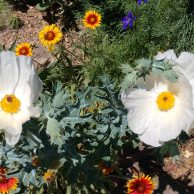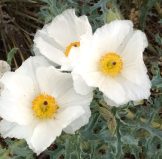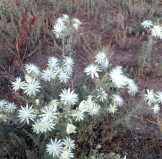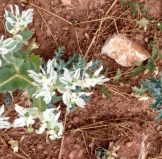
Argemone polyanthemos
by Mikl Brawner
DitchWeeds, Wildflowers, Native Forbs
Call them what you will: when Nature chooses, She knows what She’s doing. And She doesn’t need a human audience. Nature is happy playing to the bees, wasps, butterflies, moths and beetles. We humans can learn a thing or two just by noticing and appreciating Nature’s perfect performance. And that’s just what we gardeners do.
We get inspired in wild spaces, then bring some of that Nature into our home ecosystems when we find those plants at our local nurseries. 21st Century gardeners are getting it; gardening is not just about beauty anymore. It’s also about community, and supporting the soil life and insect and bird life that make a garden a more genuine piece of Nature.
Here are some native plants that bloom summer into fall with no one to water, weed or manage pests:

Prickly Poppy
Prickly Poppy, Argemone polyanthemos, is truly a member of the poppy family and it is truly prickly too. Few people are brave enough to take one home from a nursery, because when it is not in bloom with the white papery petals, it looks like a nasty thistle. The two varieties found in our area are Argemone hispida and Argemone polyanthemos. Claude Barr, in his beloved book Jewels of the Plains, wrote “One handles Argemone hispida, an all gray plant with villainous prickles, with tongs when mature, but cherishes it for its rare silver color and its fresh white flowers borne over a long season…marvels of crinkled silk which flutter without fainting through the hottest of summer breezes.” Argemone polyanthemos is much the same, growing to around 20”, preferring a light, lean soil in a sunny location. Argemone hispida is longer lived and not as tall, but both self-sow happily if given a chance. I once had a self-sown Prickly Poppy growing near a white rose in my xeriscape garden that completely outperformed the rose in beauty and in length of bloom. Argemone will happily grow and bloom with no irrigation after establishing. It is very attractive to many species of bees.
Mentzelia is another beauty that looks like a weed in a nursery pot. Its common names, Blazing Star or Evening Star, describe its large, dramatic white or yellow star-like flowers. Of the 24 species of Mentzelia described in Jennifer Ackerfield’s Flora of Colorado, the most common around here are: Mentzelia decapetala with elegant 3”-4” broad 10-petalled creamy, evening-scented stars; M. multiflora with pale yellow/cream petals; M. nuda with narrow 10-petalled stars; M. speciosa with yellow petals; and annual Mentzelia albicaulis with white stems and yellow flowers Most are biennial or perennial, 1’-3’ tall and most bloom from late afternoon or evening until morning.

Mentzilia nuda
Mentzelia nuda is stunning with its many showy, yellow-tipped stamens over the 10-petalled white star. It will bloom from June or July until October and survive up to 6500’. The plants attract dozens of bees, mostly honeybees. The common name for Mentzelia nuda is Stickleaf, because its Velcro-like leaves cling readily to clothing. Because this gorgeous flower comes with clothes-grabbing leaves, it has been called and used as the “Cowboy Corsage”. Mentzelias need no irrigation and will not survive overwatering.
Euphorbia marginata is a showy annual that looks a little like a poinsettia. The gray leaves are overshadowed by large white bracts with green center

Euphorbia marginata
lines. This effect gives the plant its common name “Snow on the Mountain”. In the center of the white spectacle is a hardly noticeable true flower. When I visited this plant growing along a busy highway, this tiny flower was attracting the passionate attentions of four kinds of wasps, both tiny and large, and two kinds of bees. This xeric native looks a lot like a variegated bedding plant and appears out of place among the dry bare ground and prairie dogs (who won’t touch it). It grows 1’-3’ tall and self-sows some.
Other late-blooming, beautiful, native, pollinator-feeding DitchWeeds are:
Gayfeather or Blazing Star (Liatris punctata), Purple Prairie Clover (Dalia purpurea), Common Sunflower (Helianthus annuus), Showy Milkweed (Asclepias speciosa), Curlycup Gumweed (Grindelia squarrosa), Mexican Hat or Yellow Coneflower (Ratbida columnifera), Rabbitbrush (Ericameria sp.) and Broom Snakeweed (Gutierrezia sarothrae)—just to name a few.
All these plants serve well in a water-smart garden and should not be overwatered. They should be placed together with other plants of similar water needs. If you include even one moderate water-loving plant (like moist-prairie Echinacea purpurea) you will be tempted to water these truly xeric natives too much. Just plant or move the Echinacea together with the Shasta Daisies and Monardas. Gardeners often think one or two plants of one kind are enough, but the visiting pollinators want bigger patches of the same plant for the efficiency of collecting food. The neighbors, and you too, will like the visual impact of some masses of color. Support Nature in your garden, in the wild and in Open Spaces. The community of beings will thank you.
